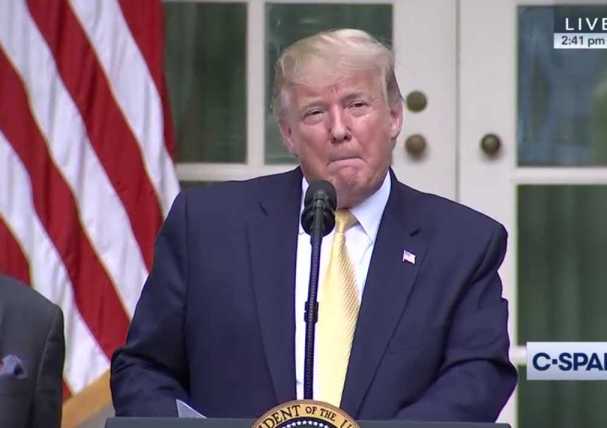
His decision not to speed toward a head-on collision with Chief Justice John Roberts, could be viewed as a real milestone in Trump’s Presidency.
Especially among those wondering if the President has any limits, or any respect for the rule of law at all. Now it looks like he might. Then again, maybe not. (What’s the “rule of law” anyway? We hear that term thrown around a lot these days as if everyone’s supposed to automatically know what it means. Here’s how we understand it: “the reining in of a capricious exercise of power by well-defined and respected laws.”)
Anyway, Trump drew a line despite his threats to the contrary, at attempting to overrule a ruling by the Supreme Court by contradicting it with an Executive Order. At least with the current composition of the Court, and even though his Attorney General seems generally very eager to challenge the limits of Presidential power with a view toward expanding it.
No way of knowing if Trump did it ultimately out of respect for the Supreme Court, or because he knew he couldn’t win if the case went back there. Or maybe this just wasn’t the time for it, given that Chief Justice Roberts was the determining vote in a 5-4 decision, which is the slimmest of all possible margins. And this would all have played out very differently with just one more ultra-Conservative on the Court, which might not be all that far fetched.
Instead, Trump orders “every department and agency in the federal government” to give the Commerce Department all “legally accessible records in their possession immediately”, regarding what the size of the “non-citizen population” in the U.S. might be right now. Those departments and agencies, which previously had kept a lot of data confidential, will now have the President’s go-ahead to share it. “Leave no stone unturned”, as he puts it. Which is an interesting though not inconsistent characterization of undocumented immigrants as the type of thing you might find under a rock.
It does raise the question however of “why”? Trump’s newfangled “count of illegals” can’t be used for redistricting. Only the actual census (now minus the question) can be. The Constitution makes that crystal clear. So if that’s the case, why bother with Trump’s new count? Just to ameliorate him? Give him a count he likes vs. the 2020 census, which he won’t? Seems like it. Unless there’s some “long game”…
And Trump strongly hinted that there is. Which is something for some reason almost no one is paying attention to. It is a little complicated. Trump in his statement about his Executive Order (he took no questions, so he was pretty clearly just reading something written by lawyers) he lays out a rather complicated blueprint, which might be totally delusional, or might be doable. And the way he lays it out, “Trump’s count” could still impact redistricting in a strong way. Here’s how: the Supreme Court also recently ruled that it can’t do anything about partisan gerrymandering, so if certain states decide to build voting districts based on eligible voters instead of total number of people living there, they can gerrymander those districts to reflect that, and nobody can really do anything about it.
Here’s a clip of Trump working his way through that diabolical scenario (click on the photo to watch):

Could that work? Yeah… Except that most of the places that could apply are currently Democratic states, and there still could be an argument using “Trump’s count” in that way violates the Enumeration Clause (or Article 1, Section 2) of the Constitution in a manner that goes beyond gerrymandering, or could even open the door–as long as we’re turning the Enumeration Clause on its head–for Democrats to question why some states have any Representatives at all, considering they don’t qualify number-wise (and they’d still have two Senators each anyway). Currently, 7 states have just one Representative. They are: Alaska, Delaware, Montana, North Dakota, South Dakota, Vermont, and Wyoming. Here’s a really good discussion of what the Constitution says about the Census, and how that’s in fact significantly changed over the years. Good weekend reading.
Anyhow, by the time Trump got to this, he’d already moved on to something else, which ended up getting a lot more coverage due to its basic incendiary nature: his so-called “Social Media Summit”, where he invited a bunch of mostly far-right, often shady (in their support of easily disproveable conspiracy theories), figures to the White House for an extraordinarily long speech about how major media companies are unfairly suppressing many of those voices.
His above all.
This is classic Trump: simultaneously boasting about how many Twitter followers he’s got, while at the very same time griping about how big a victim he is: “I have millions and millions of people, so many people you wouldn’t believe it, but I know I’ve been blocked“. And complaining about how many of the people who want access to him can’t get to him—“Sir, we want to follow you; they don’t let us on”– and blaming major media for that. And while ostensibly advocating for free speech, Trump seemed to draw a line there as well: if the media reports anything he thinks is “good” as “bad” and it makes him angry, that shouldn’t count as free speech.
Here’s Trump enumerating some of his online experiences in obsessive detail:

